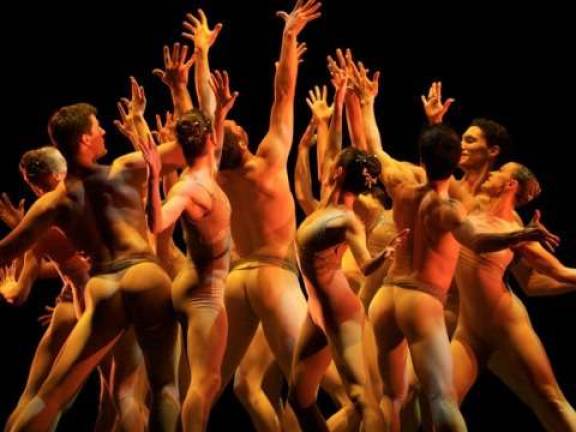Mavericks of American Dance

The Joffrey Ballet was an integral, vibrant element of the New York dance scene during the 1960s, '70s and '80s, but more recently it has barely been visible in the city. For those who attended its performances (at one point, the highly popular company had two six-week seasons a year at City Center) during those decades, memories of its distinctive repertory ? a mix of trendy pieces attuned their moment in time, and historical gems that Robert Joffrey lovingly curated ? remain vivid. But the Joffrey went through some tough financial times and retrenchment soon after its founder's death in 1988. It has since revived and flourished as a Chicago-based company, but by now it is, inevitably, just a name to a whole generation of dancegoers. Joffrey: Mavericks of American Dance, a documentary by Chicago filmmaker Bob Hercules, conveys much of the vigor and individuality that marked the beginnings and development of this feisty troupe. Necessarily, its 90 minutes do not paint a complete picture, and each Joffrey aficionado may find certain crucial elements ? such as acknowledgement of its extensive Frederick Ashton repertory, or the unique bi-coastal arrangement that gave it homes in both LA and New York during the 1980s ? notably absent. (A fair number of segments that were cut during the final editing will be included in the film's June DVD release, which will have 45 minutes of bonus material.) The documentary opens April 27 at Cinema Village ? an appropriate venue, since it is a few blocks from where Joffrey opened his school and launched his company in the 1950s. The film emphasizes how Joffrey and co-founder Gerald Arpino carved out a distinctly American profile for their enterprise, which was a clear underdog compared to the far more established and well-supported New York City Ballet and American Ballet Theatre. The earliest repertoire featured works choreographed by Joffrey, but Arpino ? a facile, if popular, choreographer ? soon took over as resident choreographer. But alongside his works, which often tapped into the cultural zeitgeist and political unrest of the moment, the company began to build an enduring repertory of long-neglected, rarely seen works from the Diaghilev era. The film features interviews with quite a few former and current Joffrey dancers, including several from the original six-member troupe that set out on tour in a station wagon in 1956. Tellingly, it includes a graphic showing how many current artistic directors of companies around the country had ties to the Joffrey. Hercules emphasizes how Joffrey selected dancers based on their individuality rather than any preconception of classical idea. Certainly the fact that he attended a High School of Performing Arts dance program during the late 1960s, and immediately signed up Gary Chryst and Christian Holder, indicates what a unique eye for talent he had. Both dancers became vividly iconic members of the company as it rode to a new level of popularity and impact, creating memorable roles and interpreting historic ones as well. There are vivid recollections, and scenes from, the company's 1963 tour to Russia; they were performing there when JFK was shot, and received wordless expressions of sympathy from ordinary Russians on the street. The company members' involvement in the anti-war sentiments and protests of the late 1960s, and the defiant tone that performances of Arpino's rock ballet Trinity, exemplify how uniquely in touch with current events the Joffrey often was. The film's chronicling of the role played by Rebekah Harkness, a Standard Oil heiress with pretensions to an artistic career, sums up the double-edged sword of private patronage. Suddenly, in the early 1960s, the company had a comfortable place to commission and rehearse new works, and a new sense of stability. But when Harkness demanded a greater artistic voice and insisted on giving the company her name, a devastating rupture ensued, and Joffrey had to resurrect his company from scratch. Several dancers from that era suggest that he was never the same after that crisis ? that he never again could trust, or be as close to, dancers. The documentary's repertory excerpts depend heavily on public television's Dance in America programs, but Hercules did find some unexpected and crucial pieces of footage. Despairing that there was no film of the original cast of Twyla Tharp's seminal Deuce Coupe, he came across unlabeled Betamax tapes that included rehearsal footage of that work, as well as early rehearsal footage of The Green Table. For a very different, one-time only ballet experience in a movie theater, head to BIG Cinema on Sunday April 29 for the latest live HD presentation from the Bolshoi Ballet. They'll be performing Alexei Ratmansky's delightful, robust comic work The Bright Stream. It's an opportunity to see it performed by the company for which he made it (with the bold, vivacious Maria Alexandrova in the role she created), just before American Ballet Theatre brings its version to the Met this spring. Joffrey: Mavericks of American Dance April 27 ? May 3, Cinema Village, 22 E. 12 St. (betw 5th & 6th Aves.), [http://www.cinemavillage.com](http://www.cinemavillage.com/). Film info: [http://www.joffreymovie.com.](http://www.joffreymovie.com/). Ballet in Cinema: The Bight Stream April 29 at 11 a.m., BIG Cinemas, 239 E. 59 St. (betw. 2nd & 3rd Aves.).